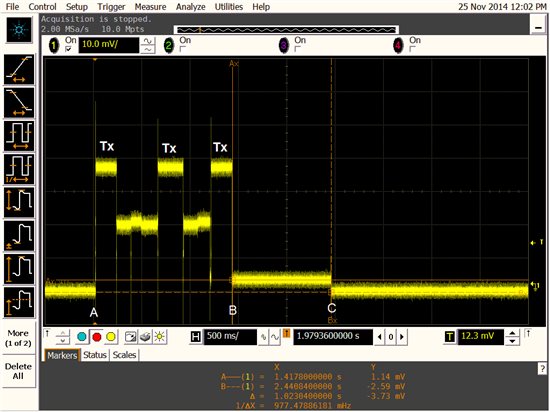I'm using the CC1110 with SIMPLICITI 1.2.0. My main End Device function it's a simple loop that transmit the internal temperature over the radio and then enter PM2 for 5 minutes.
This is the main function:
void main()
{
/* Initialize Board */
BSP_Init();
/* Send Join request */
SMPL_Init(RxCB);
while (SMPL_SUCCESS != SMPL_Link(&sLinkID1))
{
SPIN_ABOUT_A_SECOND; /* calls nwk_pllBackgrounder for us */
}
while (1)
{
/* If Packets arrived */
while(awake_flag)
{
if(sSemaphore) /* If there is packets... */
{
sSemaphore = 0;
SMPL_Receive( sLinkID1, rxmsg, &length );
processMessage(rxmsg, length);
}
}
/* Send Sensor Data */
GetSensorData(SensorData);
/*Transmit frame */
SMPL_Send(sLinkID1, SensorData, sizeof(SensorData));
/* Set sleep timer and enter PM2 according to datasheet */
BSP_SleepFor(PM2,1SECOND_RESOLUTION, Sleep_Time);
}
}
The SleepFor function is form the CC1110 Mini DK Software Example (swrc133)
void BSP_SleepFor(uint8_t mode, uint8_t res, uint16_t steps)
{
// Set radio to sleep
SMPL_Ioctl(IOCTL_OBJ_RADIO,IOCTL_ACT_RADIO_SLEEP,0);
IEN2 &= ~0x01; // Disable RF interrupt
BSP_DISABLE_INTERRUPTS();
BSP_SET_MAIN_CLOCK_RC(); // Set main clock source to RC oscillator
// Update Sleep timer
WORCTL = 0x04 + (res&0x03); // Reset timer and set resolution, mask out the 2 LSB's.
uint8_t temp = WORTIME0; // Wait one full 32kHz cycle to allow sleep timer to reset
while( temp == WORTIME0);
temp = WORTIME0;
while( temp == WORTIME0);
WOREVT1 = (steps>>8); // Set timer high byte
WOREVT0 = (uint8_t)steps; // Set timer Low byte
STIF = 0; // Clear Sleep Timer flag in IRCON
WORIRQ = 0x10; // 0x12 Enable Interupts and clear module flag
STIE = 1; // Enable Sleep Timer interrupt.
BSP_ENABLE_INTERRUPTS();
bsp_PowerMode(mode);
BSP_SET_MAIN_CLOCK_XOSC(); // Set main clock source to External oscillator
// Wake up the radio and set it in Idle
SMPL_Ioctl(IOCTL_OBJ_RADIO, IOCTL_ACT_RADIO_AWAKE,0);
IEN2 |= 0x01; // Enable RF interrupt
}
void bsp_PowerMode(uint8_t mode)
{
if (mode == POWER_MODE_2 || mode == POWER_MODE_3)
{
// NOTE! At this point, make sure all interrupts that will not be used to
// wake from PM are disabled as described in chapter 13.1.3 of the datasheet.
// Store current DMA channel 0 descriptor and abort any ongoing transfers if the channel is in use
uint8_t storedDescHigh = DMA0CFGH;
uint8_t storedDescLow = DMA0CFGL;
uint8_t storedDmaArm = DMAARM;
DMAARM |= 0x81;
// Update descriptor with correct source
if( mode == 2 )
{
dmaDesc[0] = (uint8_t) ((uint16_t)&pm2Buf >> 8);
dmaDesc[1] = (uint8_t) (uint16_t)&pm2Buf;
}
else
{
dmaDesc[0] = (uint8_t) ((uint16_t)&pm3Buf >> 8);
dmaDesc[1] = (uint8_t) (uint16_t)&pm3Buf;
}
// Associate the descriptor with DMA channel 0 and arm the DMA channel
DMA0CFGH = (uint16_t)&dmaDesc >> 8;
DMA0CFGL = (uint16_t)&dmaDesc;
DMAARM = 0x01;
// Allign with positive 32 kHz clock edge as described in chapter 13.8.2
// in the datasheet.
uint8_t temp = WORTIME0;
while( temp == WORTIME0);
// Make sure XOSC is powered down when entering PM2/3 and that cache of flash is disabled.
MEMCTR |= 0x02;
SLEEP = 0x04 | mode;
// Enter power mode as described in chapter 13.1.3 in the datasheet.
asm("NOP");
asm("NOP");
asm("NOP");
if( SLEEP & 0x03 ) {
asm("MOV 0xD7,#0x01"); // DMAREQ = 0x01;
asm("NOP"); // Needed to perfectly align the DMA transfer
asm("ORL 0x87,#0x01"); // PCON |= 0x01;
asm("NOP");
}
MEMCTR &= ~0x02;
// Update with original DMA descriptor and arm.
DMA0CFGH = storedDescHigh;
DMA0CFGL = storedDescLow;
DMAARM = storedDmaArm;
}
else if ( mode == POWER_MODE_1 )
{
uint8_t temp = WORTIME0;
while( temp == WORTIME0);
SLEEP |= mode;
asm("NOP");
asm("NOP");
asm("NOP");
if ( SLEEP & 0x03 )
{
PCON |= 0x01;
asm("NOP");
}
}
else if ( mode == POWER_MODE_0 )
{
PCON |= 0x01;
asm("NOP");
}
else
{
/* Not valid */
}
}
My problem is that the function SleepFor() it's taking too long to enter in PM2 (around 1 second most of the times). I did some debugging and found that the delay is when aligning with the 32KHz clock edge ( while( temp == WORTIME0) ).
I also found that every time the CC1110 wakes up and receives a command (which is not every time it wakes up) there is no delay aligning with the 32KHz clock edge.
My question is: Is there any way to reduce the time aligning with the clock edge?
My application has very limited energy resources. So, 3mA absorption (Active mode current) per 1 second it's too much.
I hope someone can give me a solution.
Thanks,
Abel.


